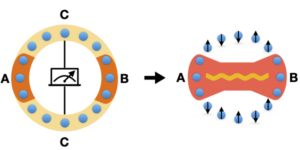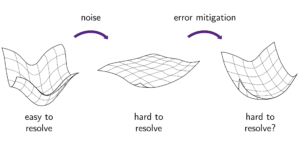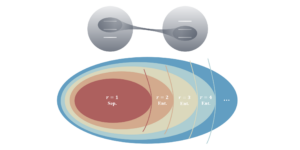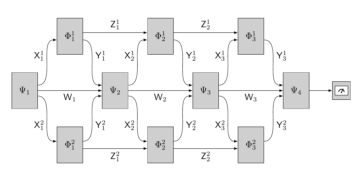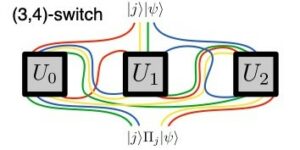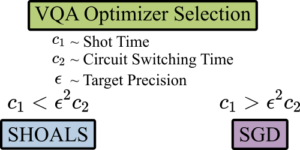1Laboratoire de Physique Subatomique et de Cosmologie, CNRS/IN2P3, 38026 Grenoble, France
2Université Paris-Saclay, CNRS/IN2P3, IJCLab, 91405 Orsay, France
Find this paper interesting or want to discuss? Scite or leave a comment on SciRate.
Abstract
We explore the possibility of adding complex absorbing potential at the boundaries when solving the one-dimensional real-time Schrödinger evolution on a grid using a quantum computer with a fully quantum algorithm described on a $n$ qubit register. Due to the complex potential, the evolution mixes real- and imaginary-time propagation and the wave function can potentially be continuously absorbed during the time propagation. We use the dilation quantum algorithm to treat the imaginary-time evolution in parallel to the real-time propagation. This method has the advantage of using only one reservoir qubit at a time, that is measured with a certain success probability to implement the desired imaginary-time evolution. We propose a specific prescription for the dilation method where the success probability is directly linked to the physical norm of the continuously absorbed state evolving on the mesh. We expect that the proposed prescription will have the advantage of keeping a high probability of success in most physical situations. Applications of the method are made on one-dimensional wave functions evolving on a mesh. Results obtained on a quantum computer identify with those obtained on a classical computer. We finally give a detailed discussion on the complexity of implementing the dilation matrix. Due to the local nature of the potential, for $n$ qubits, the dilation matrix only requires $2^n$ CNOT and $2^n$ unitary rotation for each time step, whereas it would require of the order of $4^{n+1}$ C-NOT gates to implement it using the best-known algorithm for general unitary matrices.
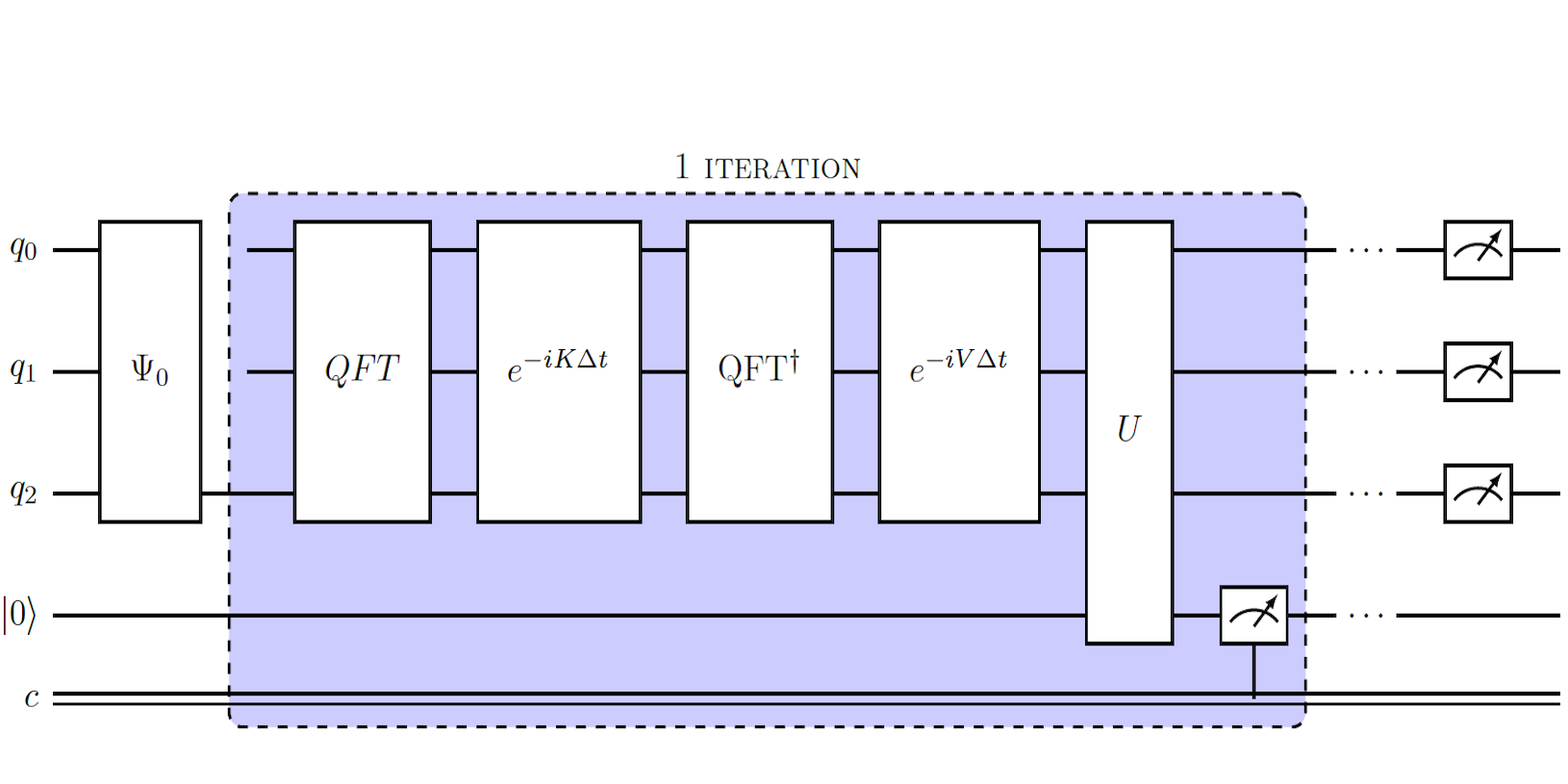
Featured image: Schematic illustration of one time-step evolution including the implementation of the Complex Absorbing Potential using the reservoir qubit (schematic example with 3 qubits only).
► BibTeX data
► References
[1] A. Smith, M. Kim, F. Pollmann, and J. Knolle, Simulating quantum many-body dynamics on a current digital quantum computer, npj Quantum Inf 5, 1 (2019).
https://doi.org/10.1038/s41534-019-0217-0
[2] B. Fauseweh and J.-X. Zhu, Digital quantum simulation of non-equilibrium quantum many- body systems, Quantum Inf. Process. 20, 138 (2021).
https://doi.org/10.1007/s11128-021-03079-z
[3] A. Macridin, et al. Digital quantum computation of fermion-boson interacting systems, Phys. Rev. A 98, 042312 (2018).
https://doi.org/10.1103/PhysRevA.98.042312
[4] S. P. Jordan, K. S. Lee, and J. Preskill, Quantum algorithms for quantum field theories, Science 336, 1130 (2012).
https://doi.org/10.1126/science.1217069
[5] Z. Meng and Y. Yang Quantum computing of fluid dynamics using the hydrodynamic Schrödinger equation, Physical Review Research 5, 033182 (2023).
https://doi.org/10.1103/PhysRevResearch.5.033182
[6] K. Bharti et al., Noisy intermediate-scale quantum (NISQ) algorithms, Rev. Mod. Phys. 94, 015004 (2022).
https://doi.org/10.1103/RevModPhys.94.015004
[7] M. Motta, C. Sun, A. T. K. Tan, M. J. O’Rourke, E. Ye, A. J. Minnich, F. G. S. L. Brandao, and G. K.-L. Chan, Determining eigenstates and thermal states on a quantum computer using quantum imaginary time evolution, Nature Physics 16, 205 (2019).
https://doi.org/10.1038/s41567-019-0704-4
[8] S. McArdle, T. Jones, S. Endo, Y. Li, S. C. Benjamin, and X. Yuan, Variational ansatz-based quantum simulation of imaginary time evolution, npj Quantum Information 5 (2019).
https://doi.org/10.1038/s41534-019-0187-2
[9] N. Gomes, F. Zhang, N. F. Berthusen, C.-Z. Wang, K.-M. Ho, P. P. Orth, and Y. Yao, Efficient step-merged quantum imaginary time evolution algorithm for quantum chemistry, Journal of Chemical Theory and Computation 16, 6256 (2020).
https://doi.org/10.1021/acs.jctc.0c00666
[10] Fabian Langkabel and Annika Bande, Quantum-Compute Algorithm for Exact Laser-Driven Electron Dynamics in Molecules, J. Chem. Theory Comput. 18, 12, 7082 (2022).
https://doi.org/10.1021/acs.jctc.2c00878
[11] Marcello Benedetti, Mattia Fiorentini, and Michael Lubasch, Hardware-efficient variational quantum algorithms for time evolution, Phys. Rev. Research 3, 033083 (2021).
https://doi.org/10.1103/PhysRevResearch.3.033083
[12] Xiao Yuan, Suguru Endo, Qi Zhao, Ying Li, Simon Benjamin, Theory of variational quantum simulation, Quantum 3, 191 (2019).
https://doi.org/10.22331/q-2019-10-07-191
[13] S. Endo, J. Sun, Y. Li, S. C. Benjamin, and X. Yuan, Variational quantum simulation of general processes, Phys. Rev. Lett. 125, 010501 (2020).
https://doi.org/10.1103/PhysRevLett.125.010501
[14] R. Sweke, I. Sinayskiy, D. Bernard, and F. Petruccione, Universal simulation of markovian open quantum systems, Phys. Rev. A 91, 062308 (2015).
https://doi.org/10.1103/physreva.91.062308
[15] R. Sweke, M. Sanz, I. Sinayskiy, F. Petruccione, and E. Solano, Digital quantum simulation of many-body non-markovian dynamics, Phys. Rev. A 94, 022317 (2016).
https://doi.org/10.1103/PhysRevA.94.022317
[16] C. Sparrow, E. Martín-López, N. Maraviglia, A. Neville, C. Harrold, J. Carolan, Y. N. Joglekar, T. Hashimoto, N. Matsuda, J. L. OBrien, D. P. Tew, and A. Laing, Simulating the vibrational quantum dynamics of molecules using photonics, Nature 557, 660 (2018).
https://doi.org/10.1038/s41586-018-0152-9
[17] Z. Hu, R. Xia, and S. Kais, A quantum algorithm for evolving open quantum dynamics on quantum computing devices, Scientific Reports 10 (2020).
https://doi.org/10.1038/s41598-020-60321-x
[18] K. Head-Marsden, S. Krastanov, D. A. Mazziotti, and P. Narang, Capturing non-markovian dynamics on near-term quantum computers, Phys. Rev. Research 3, 013182 (2021).
https://doi.org/10.1103/PhysRevResearch.3.013182
[19] Z. Hu, K. Head-Marsden, D. A. Mazziotti, P. Narang, and S. Kais, A general quantum algorithm for open quantum dynamics demonstrated with the Fenna-Matthews-Olson complex, Quantum 6, 726 (2022).
https://doi.org/10.22331/q-2022-05-30-726
[20] F. Turro, A. Roggero, V. Amitrano, P. Luchi, K. A. Wendt, J. L. Dubois, S. Quaglioni, and F. Pederiva, Imaginary-time propagation on a quantum chip, Phys. Rev. A 105, 022440 (2022).
https://doi.org/10.1103/PhysRevA.105.022440
[21] S.-H. Lin, R. Dilip, A. G. Green, A. Smith, and F. Pollmann, Real- and imaginary-time evolution with compressed quantum circuits, PRX Quantum 2, 010342 (2021).
https://doi.org/10.1103/PRXQuantum.2.010342
[22] T. Liu, J.-G. Liu, and H. Fan, Probabilistic nonunitary gate in imaginary time evolution, Quantum Inf. Process. 20, 204 (2021).
https://doi.org/10.1007/s11128-021-03145-6
[23] Taichi Kosugi, Yusuke Nishiya, Hirofumi Nishi, and Yu-ichiro Matsushita, Imaginary-time evolution using forward and backward real-time evolution with a single ancilla: First-quantized eigensolver algorithm for quantum chemistry, Phys. Rev. Research 4, 033121 (2022).
https://doi.org/10.1103/PhysRevResearch.4.033121
[24] A. W. Schlimgen , Kade Head-Marsden, LeeAnn M. Sager-Smith, Prineha Narang, and David A. Mazziotti Quantum State Preparation and Non-Unitary Evolution with Diagonal Operators, Phys. Rev. A 106, 022414 (2022).
https://doi.org/10.1103/PhysRevA.106.022414
[25] S. Wei, H. Li, and G. Long A Full Quantum Eigensolver for Quantum Chemistry Simulations. Research, 2020, (2020).
https://doi.org/10.34133/2020/1486935
[26] A.M. Childs and N. Wiebe, Hamiltonian simulation using linear combinations of unitary operations, Quant. Inf. and Comp. 12, 901 (2012).
https://doi.org/10.26421/QIC12.11-12
[27] Bruce M. Boghosian, Washington Taylor, Simulating quantum mechanics on a quantum computer, , 30 (1998).
[28] G. Benenti and G. Strini, Quantum simulation of the single-particle Schrödinger equation, Am. J. Phys. 76, 657-663 (2008).
https://doi.org/10.1119/1.2894532
[29] A.M. Childs, J. Leng, T. Li, J.P. Liu, C. Zhang, Quantum simulation of real-space dynamics, Quantum 6, 860 (2022).
https://doi.org/10.22331/q-2022-11-17-860
[30] D. Neuhauser, M. Baer, The time-dependent Schrödinger equation: Application of absorbing boundary conditions, J. Chem. Phys. 90 4351 (1988).
https://doi.org/10.1063/1.456646
[31] A. Vibok, B. Balint-Kurti, Parametrization of complex absorbing potentials for time-dependent quantum dynamics, J. Phys. Chem. 96, 8712 (1992).
https://doi.org/10.1021/j100201a012
[32] T. Seideman, W. H. Miller. Quantum mechanical reaction probabilities via a discrete variable representation-absorbing boundary condition Green’s function, J. Chem. Phys. 97, 2499 (1992).
https://doi.org/10.1063/1.463088
[33] U. V. Riss, H-D. Meyer, Calculation of resonance energies and widths using the complex absorbing potential method, J. Phys. B 26, 4503 (1993).
https://doi.org/10.1088/0953-4075/26/23/021
[34] M. Mangin-Brinet, J. Carbonell, and C. Gignoux, Exact boundary conditions at finite distance for the time-dependent Schrödinger equation, Phys. Rev. A 57, 3245 (1998).
https://doi.org/10.1103/PhysRevA.57.3245
[35] X. Antoine, C. Besse, Unconditionally stable discretization schemes of non-reflecting boundary conditions for the one- dimensional Schrödinger equation, J. Comput. Phys 188, 157 (2003).
https://doi.org/10.1016/S0021-9991(03)00159-1
[36] X. Antoine, A. Arnold, C. Besse, M. Ehrhardt, A. Schädle. A review of transparent and artificial boundary conditions techniques for linear and nonlinear Schrödinger equations, Commun. comput. Phys 4 729 (2008).
https://api.semanticscholar.org/CorpusID:28831216
[37] Hans Hon Sang Chan and Richard Meister and Tyson Jones and David P. Tew and Simon C. Benjamin, Grid-based methods for chemistry simulations on a quantum computer, Science Advances 9, eabo7484 (2023).
https://doi.org/10.1126/sciadv.abo7484
[38] H. F. Trotter, On the product of semi-groups of operators, Proc. Am. Math. Soc. 10, 545 (1959).
https://doi.org/10.1090/S0002-9939-1959-0108732-6
[39] M. Suzuki, Decomposition Formulas of Exponential Operators and Lie Exponentials with Some Applications to Quantum Mechanics and Statistical Physics, J. Math. Phys. (N.Y.) 26, 601 (1985).
https://doi.org/10.1063/1.526596
[40] Michael A. Nielsen and Isaac L. Chuang. Quantum Computation and Quantum Information, Cambridge University Press, Cambridge ; New York, 10th anniversary ed edition, 2010.
https://doi.org/10.1017/CBO9780511976667
[41] T. Ayral, P. Besserve, D. Lacroix and A. Ruiz Guzman, Quantum computing with and for many-body physics, Eur. Phys. J. A 59 (2023).
https://doi.org/10.1140/epja/s10050-023-01141-1
[42] Qiskit Development Team, Qiskit: An Open-source Framework for Quantum Computing, (2021). Qiskit: An Open-source Framework for Quantum Computing, (2021).
https://doi.org/10.5281/zenodo.2573505
[43] R. Kosloff and D. Kosloff, Absorbing Boundaries for Wave Propagation Problems, J. of Comp. Phys. 63, 363-376 (1986).
https://doi.org/10.1016/0021-9991(86)90199-3
[44] M.D. Feit, J. Fleck,Jr.,A. Steiger, Solution of the Schrödinger equation by a spectral method, J. Comput.Phys. 47, 412 (1982).
https://doi.org/10.1016/0021-9991(82)90091-2
[45] N. Balakrishnan, C. Kalyanaraman, N. Sathyamurthy, Time-dependent quantum mechanical approach to reactive scattering and related processes, Phys. Rep. 280, 79 (1997).
https://doi.org/10.1016/S0370-1573(96)00025-7
[46] A. M. Krol, K. Mesman, A. Sarkar, M. Moller, Z. Al-Ars, Efficient Decomposition of Unitary Matrices in Quantum Circuit Compilers, Appl. Sci. 12, 759 (2022).
https://doi.org/10.3390/app12020759
[47] Anthony W. Schlimgen, Kade Head-Marsden, LeeAnn M. Sager-Smith, Prineha Narang, and David A. Mazziotti, Quantum state preparation and nonunitary evolution with diagonal operators, Phys. Rev. A 106, 022414 (2022).
https://doi.org/10.1103/PhysRevA.106.022414
[48] V. Shende, S. Bullock, and I. Markov, Synthesis of quantum–logic circuits, IEEE Trans. Comput. Aided Des. Integr. Circuits Syst. 25, 1000 (2006).
https://doi.org/10.1109/TCAD.2005.855930
[49] R. R. Tucci A Rudimentary Quantum Compiler, 2nd Edition, quant-ph/9902062.
https://doi.org/10.48550/arXiv.quant-ph/9902062
arXiv:quant-ph/9902062
[50] M. Mottonen et al., Quantum circuits for general multi-qubit gates, Phys. Rev. Lett. 93, 130502, 2004.
https://doi.org/10.1103/PhysRevLett.93.130502
[51] M. Mottonen and J. Vartiainen, Decompositions of general quantum gates, Ch. 7 in Trends in Quantum Computing Research (NOVA Publishers, New York), 2006. arXiv:quant-ph/0504100.
https://doi.org/10.48550/arXiv.quant-ph/0504100
arXiv:quant-ph/0504100
[52] N. Michel and M. Ploszajczak, Gamow Shell Model: The Unified Theory of Nuclear Structure and Reactions, Lecture Notes in Physics, 983 (2021).
https://doi.org/10.1007/978-3-030-69356-5
Cited by
This Paper is published in Quantum under the Creative Commons Attribution 4.0 International (CC BY 4.0) license. Copyright remains with the original copyright holders such as the authors or their institutions.
- SEO Powered Content & PR Distribution. Get Amplified Today.
- PlatoData.Network Vertical Generative Ai. Empower Yourself. Access Here.
- PlatoAiStream. Web3 Intelligence. Knowledge Amplified. Access Here.
- PlatoESG. Carbon, CleanTech, Energy, Environment, Solar, Waste Management. Access Here.
- PlatoHealth. Biotech and Clinical Trials Intelligence. Access Here.
- Source: https://quantum-journal.org/papers/q-2024-04-08-1311/
- :has
- :is
- :where
- ][p
- 1
- 10
- 10th
- 11
- 12
- 125
- 13
- 14
- 15%
- 16
- 17
- 19
- 1985
- 1998
- 20
- 2005
- 2006
- 2008
- 2012
- 2015
- 2016
- 2018
- 2019
- 2020
- 2021
- 2022
- 2023
- 204
- 22
- 23
- 24
- 25
- 26%
- 27
- 28
- 29
- 2nd
- 30
- 31
- 32
- 33
- 35%
- 36
- 39
- 40
- 41
- 43
- 49
- 50
- 51
- 7
- 8
- 9
- 91
- 97
- 98
- a
- a.m
- absorbed
- ABSTRACT
- access
- adding
- advances
- ADvantage
- affiliations
- AL
- algorithm
- algorithms
- am
- an
- and
- Anniversary
- Anthony
- Application
- applications
- approach
- apr
- ARE
- artificial
- AS
- At
- author
- authors
- Baer
- BE
- Benjamin
- body
- boundaries
- boundary
- Break
- Bruce
- by
- calculation
- cambridge
- CAN
- Capturing
- certain
- chan
- chemical
- chemistry
- chip
- combinations
- comment
- Commons
- COMP
- complex
- complexity
- computation
- computer
- computers
- computing
- computing research
- condition
- conditions
- continuously
- copyright
- Current
- David
- de
- demonstrated
- described
- desired
- detailed
- determining
- Development
- development team
- Devices
- digital
- directly
- discuss
- discussion
- distance
- due
- during
- dynamics
- e
- E&T
- each
- ed
- edgar
- edition
- efficient
- equations
- EUR
- evolution
- evolving
- exact
- example
- expect
- explore
- exponential
- fan
- field
- Finally
- fluid
- Fluid dynamics
- For
- Forward
- Framework
- full
- fully
- function
- functions
- gate
- Gates
- General
- Give
- Green
- Grid
- guzman
- hans
- Have
- High
- holders
- HTTPS
- i
- identify
- IEEE
- image
- imaginary
- implement
- implementation
- implementing
- in
- Including
- information
- institutions
- interacting
- interesting
- International
- IT
- JavaScript
- jones
- Jordan
- journal
- keeping
- Kim
- Leave
- Lecture
- Lee
- Li
- License
- lie
- lin
- linear
- linked
- local
- Long
- made
- math
- Matrix
- max-width
- mechanical
- mechanics
- mesh
- method
- methods
- Meyer
- Michael
- Miller
- mixes
- model
- Month
- most
- Nature
- New
- New York
- nonlinear
- Notes
- nuclear
- obtained
- of
- on
- ONE
- only
- open
- open source
- Operations
- operators
- or
- order
- original
- pages
- Paper
- Parallel
- physical
- Physics
- plato
- Plato Data Intelligence
- PlatoData
- possibility
- potential
- potentially
- potentials
- preparation
- prescription
- press
- probabilities
- problems
- PROC
- process
- processes
- Product
- propose
- proposed
- published
- publisher
- publishers
- Qi
- qiskit
- Quant
- Quantum
- quantum algorithms
- Quantum Computer
- quantum computers
- quantum computing
- quantum information
- Quantum Mechanics
- quantum systems
- Qubit
- qubits
- R
- reaction
- reactions
- real-time
- references
- register
- related
- remains
- Reports
- require
- requires
- research
- resonance
- Results
- review
- Richard
- ruiz
- s
- schemes
- SCI
- Science
- scientific
- Shell
- Simon
- simulation
- simulations
- single
- situations
- smith
- solution
- Solving
- some
- sparrow
- specific
- Spectral
- stable
- State
- States
- statistical
- Step
- structure
- success
- such
- Sun
- synthesis
- Systems
- team
- techniques
- that
- The
- their
- theory
- thermal
- this
- those
- time
- Title
- to
- transparent
- treat
- Trends
- under
- unified
- Universal
- university
- URL
- use
- using
- variable
- via
- volume
- W
- wang
- want
- washington
- Wave
- we
- when
- whereas
- will
- with
- would
- X
- xiao
- Ye
- year
- YING
- york
- Yuan
- zephyrnet
- Zhao


